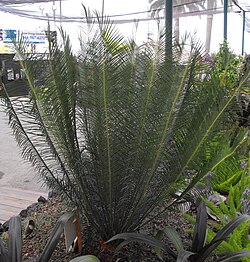| Dukou sago palm | |
|---|---|
 | |
| On display at the San Diego County Fair in 2009 | |
| Scientific classification | |
| Kingdom: | Plantae |
| Clade: | Tracheophytes |
| Clade: | Gymnospermae |
| Division: | Cycadophyta |
| Class: | Cycadopsida |
| Order: | Cycadales |
| Family: | Cycadaceae |
| Genus: | Cycas |
| Species: | C. panzhihuaensis |
| Binomial name | |
| Cycas panzhihuaensis L. Zhou & S. Y. Yang | |
| Synonyms | |
Cycas baguanheensisL. K. Fu & S. Z. Cheng. | |
Cycas panzhihuaensis is a rare and vulnerable species of cycad known in the wild only from Sichuan and Yunnan provinces in China. It can be seen at the South China Botanical Garden in Guangzhou and is also cultivated for horticulture, where it is often known as the Dukou sago palm. [2] [3]
